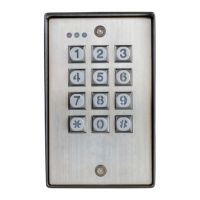
Do you have a question about the SECO-LARM SK-1123-SQ and is the answer not in the manual?
Explains how to use the keypad with standard user codes for door access.
Details on using the master code for door operation or keypad programming.
Information on inhibit mode and its operation as explained by the installer.
References the explanation of duress codes and their specific uses on page 12.
Procedure for managing user codes and the master code, with warnings.
Instructions for changing specific data within the keypad, like user codes.
Process for erasing all current data and inputting new data, useful after system sale.
Steps to remove a user's access code from the keypad system.
Method to override a forgotten master code using a DAP jumper.
Procedure to access the installer programming mode using the master code.
Option to clear all previously stored data in the keypad.
Settings for relay outputs, including momentary mode and shunt mode.
Configuration for lockout duration and attempts after incorrect code entries.
Enables or disables an alarm when a door is forced open.
Configures a beep to announce relay output activation.
Selects between auto or manual code entry mode for users.
Controls whether the keypad beeps when a key is pressed.
Sets the allowable time a door can be left open before triggering an alarm.
Procedure to exit programming mode and return to normal operation.
Power compatibility and lack of jumpers for voltage setup.
Enables interlocking two keypads to ensure only one door is open at a time.
Allows disabling relay output #1 to increase security during specific times.
Provides a warning beep if the door is forced open without a valid code.
Warns if a door is left propped open after the allowed open time.
Option to select automatic code entry or requiring the '#' key.
Output signal for 10 seconds when any key is pressed, for external triggers.
Automatically relocks the door after time expires or upon closing.
Silent alarm trigger activated by a duress code entry.
Keypad illumination for improved visibility in low light conditions.
Illustrates the fundamental wiring connections for the keypad.
Information needed before starting keypad programming.
Initial steps and overview for programming the keypad.
Details on entering the programming mode and making changes.
General guidelines and advice for programming the keypad effectively.
Explanation of the status indicated by the red, amber, and green LEDs.
Defines the meanings of different buzzer tones and amber LED flashes.
Technical details including power, outputs, inputs, dimensions, and weight.
Example wiring for connecting with inhibit control authorization.
Wiring examples for tamper, duress output, door sensing, and alarm connections.
Example wiring for a mantrap system using two keypads.
Example wiring for connecting to lock devices and alarm control panels.
